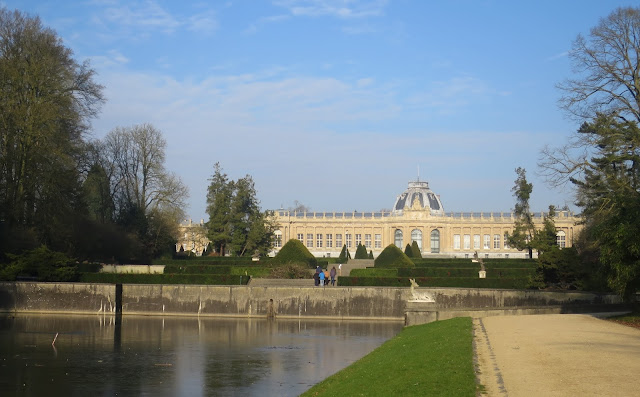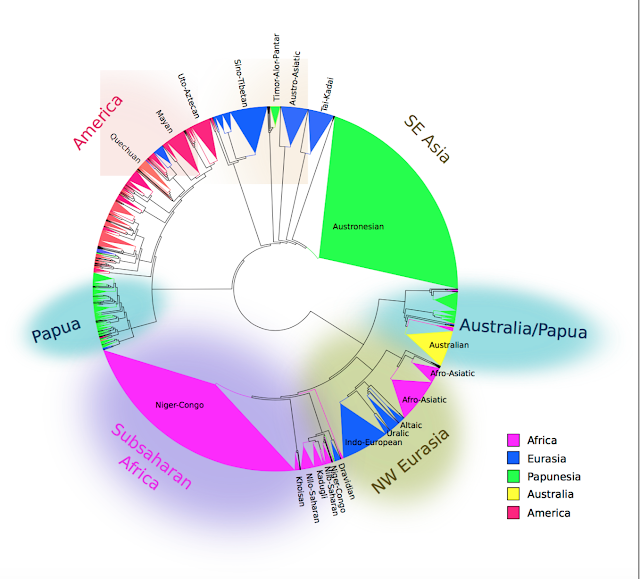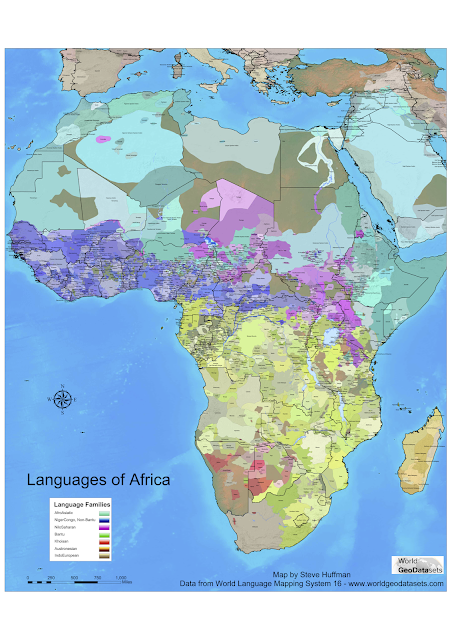A visit to the Royal Museum for Central Africa
Two weeks ago I went to visit the Royal Museum for Central Africa in Tervuren, Belgium. The reason was straightforward: in the ongoing endeavour to study Bantu gender systems, there are at least 10 north-west Bantu languages on which the only information easily available is located there. Since that is not an insignificant number as the total sample is about 250 languages, of which 50 or so with no information available anywhere, it seemed worthwhile to go there and collect as much data as possible.
The museum itself has been closed since 2013 and, bad timing on my part, is supposed to re-open late this year. The main building is spectacular, surrounded by a beautiful park, and the immense collections make the RMCA one of the worlds' centers for the study of Central Africa. Once the museum opens again, there will be a permanent exhibition on the languages and linguistics of Central Africa, so if you have a chance to go there you should totally do that.
Unfortunately, I did not set foot in the beautiful main building. The RMCA library is located in an ugly building shared with, for whatever reason, the Belgian Federal Agency for the Safety of the Food Chain. This building also houses scientists on linguistics and musicology and the main library, and most importantly the linguistics library. I was allowed to sit in the kitchen and go about my business, which I thought involved mostly coding languages as fast as I could, but which quickly evolved into photographing as much documents as I could, as I realized that I would never manage to go through everything they had on the spot.
I came across some really cool things, including Meeussen's handwritten 'Notes on Buyu', which is the only document (in the world?) on Buyu, a Bantu D language spoken in the western Democratic Republic of Congo. It was apparently lost for a while, and found again only months before I arrived, so it was pretty amazing to see it. Because it is handwritten, I had to code it on the spot, as the photographs I made (see below) are at least in part unreadable.
The document included several pages that were not intended to appear in the ultimate version of this work, which never materialized, including the page below where the author seemed to be preoccupied with drawing angles:
As it turned out, I could find no evidence that Buyu behaved any different from its better-studied sister Holoholo. Buyu and Holoholo are part of a group of languages that seems to have migrated into the forest from the south, but unlike another group of Bantu D languages that traveled through the forest, including Bila, Amba, Komo, Kari, Homa, Bodo, Bera, and Beeke, has kept a more or less traditional noun class system. Bila and sisters all have (heavily) reconstructed noun class systems, with some not having gender in any meaningful sense any longer.
Other very cool finds at the museum included mostly hand drawn maps or maps I had never seen before, but which would be great to have in a large format:
All in all, it was great to visit, even though it was really cold and I didn't have a chance to see the museum. The long-term plan is to continue with the rest of the Bantu family once the study of the north-west languages are finished, so who knows, maybe I'll get to visit again someday.
The museum itself has been closed since 2013 and, bad timing on my part, is supposed to re-open late this year. The main building is spectacular, surrounded by a beautiful park, and the immense collections make the RMCA one of the worlds' centers for the study of Central Africa. Once the museum opens again, there will be a permanent exhibition on the languages and linguistics of Central Africa, so if you have a chance to go there you should totally do that.
Unfortunately, I did not set foot in the beautiful main building. The RMCA library is located in an ugly building shared with, for whatever reason, the Belgian Federal Agency for the Safety of the Food Chain. This building also houses scientists on linguistics and musicology and the main library, and most importantly the linguistics library. I was allowed to sit in the kitchen and go about my business, which I thought involved mostly coding languages as fast as I could, but which quickly evolved into photographing as much documents as I could, as I realized that I would never manage to go through everything they had on the spot.
I came across some really cool things, including Meeussen's handwritten 'Notes on Buyu', which is the only document (in the world?) on Buyu, a Bantu D language spoken in the western Democratic Republic of Congo. It was apparently lost for a while, and found again only months before I arrived, so it was pretty amazing to see it. Because it is handwritten, I had to code it on the spot, as the photographs I made (see below) are at least in part unreadable.
The document included several pages that were not intended to appear in the ultimate version of this work, which never materialized, including the page below where the author seemed to be preoccupied with drawing angles:
As it turned out, I could find no evidence that Buyu behaved any different from its better-studied sister Holoholo. Buyu and Holoholo are part of a group of languages that seems to have migrated into the forest from the south, but unlike another group of Bantu D languages that traveled through the forest, including Bila, Amba, Komo, Kari, Homa, Bodo, Bera, and Beeke, has kept a more or less traditional noun class system. Bila and sisters all have (heavily) reconstructed noun class systems, with some not having gender in any meaningful sense any longer.
Other very cool finds at the museum included mostly hand drawn maps or maps I had never seen before, but which would be great to have in a large format:
Makila, Moyo-Kayita. (1981) Esquisse de grammaire mbala: morphologie et syntaxe. Lubumbashi: Université Nationale du Zaïre (UNAZA) MA thesis.
Nkabuwakabili, A. (1986) Esquisse de la langue Boa (C44). Université Libre de Bruxelles MA thesis.
Nzang-Bie, Yolande. (1989) Éléments du description du mmǎlá: langue bantu de zone A. Université Libre de Bruxelles MA thesis.
All in all, it was great to visit, even though it was really cold and I didn't have a chance to see the museum. The long-term plan is to continue with the rest of the Bantu family once the study of the north-west languages are finished, so who knows, maybe I'll get to visit again someday.









Comments
Post a Comment